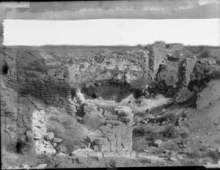Article
Also known as Ha'wi-k'uh, the ancestral village of the Zuni was founded in the 1400s. It was the largest of the Zuni pueblos, and the first pueblo to be seen by Spanish explorers. Originally thought to be one of the fabled gold Cities of Cíbola, Ha'wi-k'uh was conquered by Coronado in 1540 and served as his headquarters for several months. Ha'wi-k'uh was permanently abandoned after the 1680 Pueblo Revolt. In its prime, Ha'wi-k'uh had up to 150 rooms surrounding a central plaza and stood four stories high, with multiple numbers of kivas and a population between 500 to 700 individuals. Although Ha'wi-k'uh is now a series of ruins that run along a ridge several miles south of the current thriving pueblo, it remains an important cultural site for the Zuni and is an integral component in many of their migration and origin stories, ceremonies, and prayers.
The ruins of Ha'wi-k'uh were designated a National Historic Landmark in 1961.
"Hawikuh ruins, Zuni Pueblo, New Mexico, 1925," photograph by Edward S. Curtis. Edward S. Curtis Collection (144667). Palace of the Governors Archive, New Mexico History Museum, Santa Fe.
Manuscripts
References
Kessel, William B., and Robert Wooster
2005 Zuni and Warfare. Encyclopedia of Native American Wars and Warfare. New York:
Facts On File, Inc.
National Park Service
N.d. Hawikuh. http://www.nps.gov/nr/travel/amsw/sw30.htm, accessed August 29, 2014.

